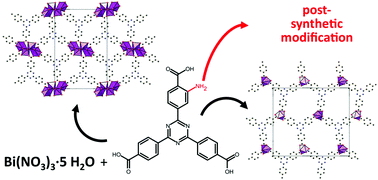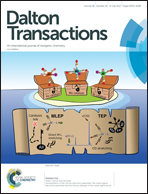Synthesis, functionalisation and post-synthetic modification of bismuth metal–organic frameworks†
Abstract
Two new bismuth metal–organic frameworks (Bi-MOFs) were discovered using high throughput experiments employing bismuth(III) nitrate pentahydrate and triazine-2,4,6-triyl-tribenzoic acid (H3TATB). The reaction was carried out for long reaction times (∼5 d) in a water/DMF-mixture and resulted in the formation of [Bi2(O)(OH)(TATB)]·H2O (denoted as CAU-35). By switching to short reaction times and a methanol/DMF-mixture as the solvent, an analogue of CAU-7-BTB with the composition [Bi(TATB)]·DMF·6H2O (denoted as CAU-7-TATB) was obtained. The use of the amino-functionalised H3TATB linker (H3TATB-NH2) resulted in the formation of a functionalised porous Bi-MOF with the composition [Bi(TATB-NH2)]·5H2O·0.5DMF (CAU-7-TATB-NH2). The structures of CAU-35 and CAU-7-TATB were successfully solved and refined from the PXRD data. CAU-7-TATB-NH2 was post-synthetically modified using anhydrides (acetic anhydride and valeric anhydride), cyclic anhydrides (succinic anhydride and phthalic anhydride), and 1,3-propane sultone. The degree of conversion ranged from 33% to 79%.



 Please wait while we load your content...
Please wait while we load your content...